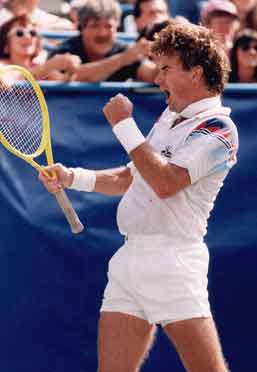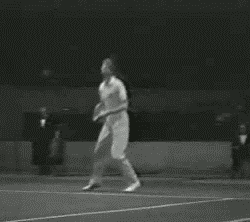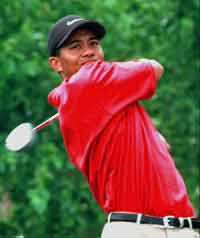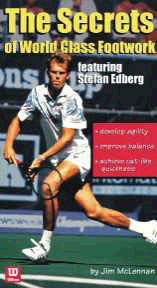<% ns_puts [mkm_getnavbar] %>
Kaizen - Is it the Missing Element in Your Game?
by Jim McLennan
Kaizen - the constant and continuous quest for improvement. Never being satisfied with your technique, your performance, your prowess.
Kaizen - Toyota engineers accelerate the assembly line until it breaks down. Then they find and fix the flaw and push the assembly line again. They repeat this process pushing the assembly line to yet higher levels of production
|
Tiger Woods wins the 1997 Masters by a colossal eleven strokes. Then calls his coach Butch Harmon to announce he wants to retool his swing. Now stop a moment. Changing a golf stroke (think tennis stroke) requires unlearning old habits, replacing those habits with new technique, then practicing enough so the new technique becomes a (new) habit. This isn’t easy.
The golfer or tennis player often
becomes overly conscious as they hit the ball, and this heightened
consciousness interferes with performance. Sure enough Tiger had
about 18 months of struggle trying to get the “feel” of his changed
swing. Now, as you are undoubtedly aware, Tiger is really feeling
it, and Coach Harmon figures Tiger is about 75% of the way there.
Are you kidding me! Tiger has three major victories this year and he
is still only 75% of the way there? Unfortunately, in most instances, players of any
ability get cornered by the style of a certain stroke and often do not
work to complete the entire repertoire of shots. The flowing rhythm
of the serve is different than the staccato approach to the volley.
The grips for the groundstrokes are different than that for the serve. The requirements for the approach and net game are totally different than
for the grinding topspin baseline rally. The challenge is to address these disparate elements, and work to bring them ALL into your game.
As you evaluate your own appreciation for Kaizen, have you avoided
learning the eastern backhand grip on your serve? Are you unwilling
to work on your net game for fear of being passed. Are you
tinkering with a drop shot return off your opponent’s generally weak
second serve, or unable to get the feel for feathering the underspin? Will you be better at the game in 5 years, or simply playing more or less
the same but with 5 additional years experience? Professional Example: Jim Courier, interviewed in Tennis Magazine, remarked early on
a coach started tinkering with his grips but the changes did not stick,
and he lamented that if only the coach had persisted. Talk about
misplaced responsibility, the quest for constant improvement comes from
within, and that may be the lesson of Earl and Tiger Woods, that Tiger was
taught early on the mind set, the attitude, and the need for constant
improvement. On the other hand, Don Budge takes an entire winter off to work on his
forehand approach. Brad Gilbert dramatically remakes his serve from
college to the professional ranks. Bjorn Borg drastically improved his serve, winning five Wimbledon’s
as proof. Borg practices his serve two hours a day during this
process. At the conclusion, his coach, Lennart Bergelin, describes Borg’s
new serve as an arrow. A teenaged Pete Sampras abandons his two handed
backhand in order to improve his approaching game and volleying technique.
Many in the Los Angeles tennis community questioned the wisdom of changing
a stroke in an accomplished junior tournament competitor. Because of
Sampras’ quest for continuous improvement, his keen awareness of the big
picture, he knew intuitively of the two handers limitations, and boldly
changed his game.
Masterstrokes are those that “tennis historians” regard as the best of
all time. That particular estimation comes from the power of those
strokes, for their accuracy, for their rhythm and style, for the
mechanical leverage and, for their unfailing
consistency day in and day out, week in week out, year in and year out. Study
these strokes, learn, improve! Pete Sampras serve and forehand. Andre Agassi two handed backhand.
Ken Rosewall underspin backhand. Don Budge overspin backhand. Lew Hoad serve.
Jimmy Connors and Andre Agassi return of serve.
To view some of the masterstrokes, click below:
Celebrate Tiger for his courage, his intelligence and for his work ethic,
for his willingness to change.

With a pure
economy of motion and a devastating two-fisted backhand, his was the best
service returner in the game.
On one occasion, while refereeing a match, Budge had seen how early Fred
Perry took the ball, running Ellsworth Vines from corner to corner. Budge knew “taking the ball on the rise” would give him a
tremendous edge, so he and Tom Stow worked all winter getting to the
forehand quickly, on balance, and in the right fashion.

Unsatisfied, Budge took an entire winter off to work on his
forehand approach.
So are you ready to push the envelop, work on the big picture, learn all facets of the
game? If so, where do you start? Begin with Tom Stow The
All Court Forcing Game. There is a clear description of a strategic
style, and the specific weapons required to master that all court style.
Review your grips. Are you unable to hit certain shots because of grip
deficiencies, if so CHANGE. Has your game improved over the past few
years, or have you reached a plateau. If so, CHANGE.
Masterstrokes
Your comments are welcome. Let us know what you think
about Jim McLennan's article by emailing
us here at TennisONE.
|
Click here to order. |
The Secrets of World Class Footwork - Featuring Stefan Edberg
Pattern movements to the volleys, groundstrokes, and split step reactions. Rehearse explosive starts, gliding movements, and build your aerobic endurance. If you are serious about improving your tennis,
footwork is the key. |
Your comments are welcome. Let us know what you think about
Jim McLennan's journal by emailing
us here at TennisONE.
Last Updated 12/1/00. To contact us, please email to: webmaster@tennisone.com
TennisONE is a registered trademark of TennisONE and SportsWeb ONE; Copyright 1995. All rights reserved.


